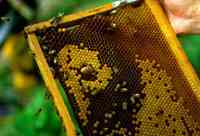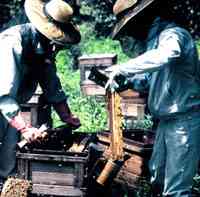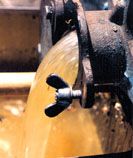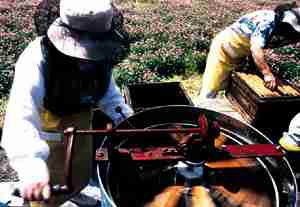1. Wait
until the honey matures. Timing is the key to honey removal.
|
|
First
we wait until the honey is mature. Timing is very important for
removal. The bees bring honey back to the hive as nectar. Its
sugar concentration is just 30 to 50% and is not yet honey as
we know it. The honeybees flap their wings to evaporate water
from the nectar on their tongues to concentrate the sugar. In
4 to 5 days, when the sugar has been concentrated to about 78%,
the bees secrete wax to form a "capping" and the honey is finally
finished. As beekeepers we make sure to wait until this capping
is formed before we extract the honey. Honey will ferment if it
is extracted too early when it is not yet mature. The key to gathering
delicious honey is to be patient and wait. |

|
|
2. How
to extract the honey
First we remove the old honey. One week before extracting the
new honey we remove the honey that has remained over the winter.
Then, just seven days later it is time to remove the new honey.
The process of honey removal is started early in the morning
and completed before the morning is over to make sure that the
unconcentrated nectar that the bees collect on that day does
not get mixed with the mature honey.
|

|
|
|
|
|
| . |
|
(1)
The frames are removed from the hive.
First we use a smoker to smoke the hive and pacify
the bees. Then we remove the frames. The bees that
cling to the frames are shaken over the hive to return
them to the colony. The technique we use is to grab
the frame with both hands and move it straight down
to a dead stop in one swift motion. This is one of
the first important techniques that the beekeeper
learns. Any bees that still cling to the frame are
swept off using a bee brush.
|
|

|
|
|
(2)
The cappings are removed with a knife and the frames
are placed into a centrifugal extractor.
Cut the capping carefully with a knife, put the frames
into the extractor, and rotate to draw out the honey.
We are careful not to rotate it too fast, which can
damage the manufactured comb foundations.
|
|

|
|
|
(3)
The honey is removed from the extractor through the
valve and then filtered.
After the honey is extracted, we replace the frame
into the hive.
|

|
|
|
|
|
|
|
|








